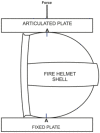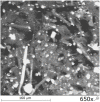Influence of Thermal Shocks on Residual Static Strength, Impact Strength and Elasticity of Polymer-Composite Materials Used in Firefighting Helmets
- PMID: 35009203
- PMCID: PMC8745901
- DOI: 10.3390/ma15010057
Influence of Thermal Shocks on Residual Static Strength, Impact Strength and Elasticity of Polymer-Composite Materials Used in Firefighting Helmets
Abstract
The article presents results of experimental studies on mechanical properties of the polymer-composite material used in manufacturing firefighting helmets. Conducted studies included static and impact strength tests, as well as a shock absorption test of glass fiber-reinforced polyamide 66 (PA66) samples and firefighting helmets. Samples were subject to the impact of thermal shocks before or during being placed under a mechanical load. A significant influence of thermal shocks on mechanical properties of glass fiber-reinforced PA66 was shown. The decrease in strength and elastic properties after cyclic heat shocks ranged from a few to several dozen percent. The average bending strength and modulus during the 170 degree Celsius shock dropped to several dozen percent from the room temperature strength. Under these thermal conditions, the impact strength was lost, and the lateral deflection of the helmet shells increased by approximately 300%. Moreover, while forcing a thermal shock occurring during the heat load, it was noticed that the character of a composite damage changes from the elasto-brittle type into the elasto-plastic one. It was also proved that changes in mechanical and elastic properties of the material used in a helmet shell can affect the protective abilities of a helmet.
Keywords: degradation; fire helmet; impact test; polymer composite; thermal shock.
Conflict of interest statement
The authors declare no conflict of interest.
Figures

















Similar articles
-
The effect of length and concentration of glass fibers on the mechanical properties of an injection- and a compression-molded denture base polymer.J Prosthet Dent. 2003 Oct;90(4):385-93. doi: 10.1016/S0022391303005183. J Prosthet Dent. 2003. PMID: 14564293
-
Effect of Organo-Modified Montmorillonite Nanoclay on Mechanical, Thermo-Mechanical, and Thermal Properties of Carbon Fiber-Reinforced Phenolic Composites.Polymers (Basel). 2021 Feb 28;13(5):754. doi: 10.3390/polym13050754. Polymers (Basel). 2021. PMID: 33670964 Free PMC article.
-
Effect of Thermal Aging on Mechanical Properties and Color Difference of Glass Fiber/Polyetherimide (GF/PEI) Composites.Polymers (Basel). 2021 Dec 24;14(1):67. doi: 10.3390/polym14010067. Polymers (Basel). 2021. PMID: 35012089 Free PMC article.
-
Influence of airborne-particle abrasion on mechanical properties and bond strength of carbon/epoxy and glass/bis-GMA fiber-reinforced resin posts.J Prosthet Dent. 2008 Jun;99(6):444-54. doi: 10.1016/S0022-3913(08)60106-7. J Prosthet Dent. 2008. PMID: 18514666
-
Research Progress on Helmet Liner Materials and Structural Applications.Materials (Basel). 2024 May 30;17(11):2649. doi: 10.3390/ma17112649. Materials (Basel). 2024. PMID: 38893913 Free PMC article. Review.
References
-
- Council Directive 89/656/EEC of 30 November 1989 on the Minimum Health and Safety Requirements for the Use by Workers of Personal Protective Equipment at the Workplace. [(accessed on 18 November 2021)]. Available online: https://eur-lex.europa.eu/legal-content/en/ALL/?uri=CELEX:31989L0656.
-
- EN 443 Helmets for Fire Fighting in Buildings and Other Structures. 2008. [(accessed on 10 November 2021)]. Available online: https://www.en-standard.eu/bs-en-443-2008-helmets-for-fire-fighting-in-b...
-
- Hamouda A.M.S., Sohaimi R.M., Zaidi A.M.A., Abdullah S. Advances in Military Textiles and Personal Equipment. Woodhead Publishing; Sawston, UK: 2012. Materials and design issues for military helmets; pp. 103–138.
-
- Pieniak D., Kamocka-Bronisz R., Walczak A. Evaluation of failure and protection effectiveness of firefighting helmets. Logistyka. 2014;5:1260–1267.
LinkOut - more resources
Full Text Sources

